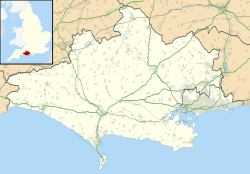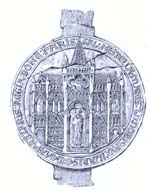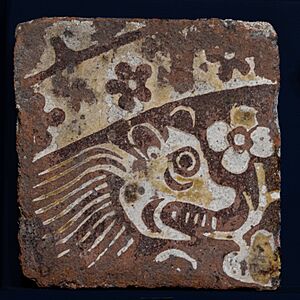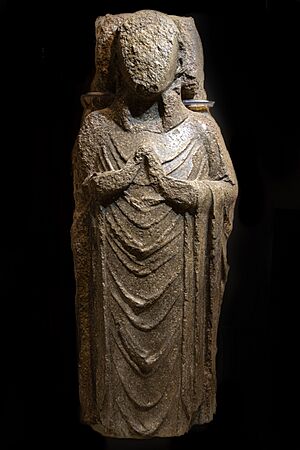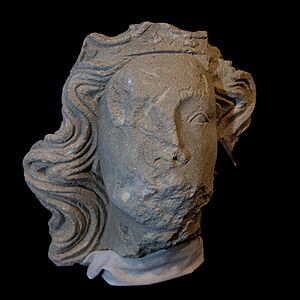Shaftesbury Abbey facts for kids

Shaftesbury Abbey ruins
|
|
| Monastery information | |
|---|---|
| Order | Benedictine |
| Established | c. 888 |
| Disestablished | 1539 |
| People | |
| Founder(s) | King Alfred the Great |
| Site | |
| Location | Shaftesbury, Dorset, England |
| Coordinates | 51°00′19″N 2°11′55″W / 51.0053°N 2.1986°W |
Shaftesbury Abbey was a very important abbey in Shaftesbury, Dorset, England. It was a special home for nuns, who were women dedicated to a religious life. King Alfred the Great started the abbey around the year 888. It was closed down in 1539 by King Henry VIII during a big change in England called the English Reformation. At that time, Shaftesbury Abbey was the second richest nunnery in all of England!
Contents
A Look Back at Shaftesbury Abbey's History
How Shaftesbury Abbey Began
King Alfred the Great founded this religious community for nuns around 888 AD. He even made his own daughter, Æthelgifu, the very first abbess (the head nun). Later, Ælfgifu, who was the wife of King Edmund I (Alfred's grandson), was buried at Shaftesbury. People soon thought of her as a saint, and many believed she was the true founder of the abbey.
The Story of Saint Edward's Relics
A very important event happened when the bones of Edward the Martyr were brought to the abbey. Edward was a young king who had died. His relics (his remains) were moved from Wareham to Shaftesbury with a huge ceremony. Important religious leaders like St Dunstan were there.
This special procession started on February 13, 981, and the relics arrived at Shaftesbury seven days later. The nuns welcomed them, and Edward's remains were buried with royal honors near the altar. People said that on the way to Shaftesbury, a miracle happened! Two men who couldn't walk were brought near the coffin, and when it was lowered to them, they were instantly healed. This amazing journey was even re-enacted 1000 years later in 1981. Many other miracles were reported at Edward's tomb, making the abbey a famous place for pilgrimage (religious journeys).
The Abbey's Growing Importance
In 1001, people noticed that St Edward's tomb seemed to rise from the ground regularly. King Æthelred then ordered that his brother's tomb be moved to an even more special place. The relics were placed in a casket with other holy items on June 20, 1001.
Shaftesbury Abbey was then rededicated to the Mother of God and St Edward. More miracles, like the healing of people who were sick or blind, were said to happen at St Edward's tomb. Because of this, the abbey became the richest Benedictine nunnery in England. It was a major destination for pilgrims and the most important place in the town. A large farm, Place Farm, was set up in Tisbury to manage the abbey's lands.
A historian named William of Malmesbury praised the nuns for their "steadfast preservation of their purity" and their powerful prayers. In 1093, a famous religious leader named Anselm of Canterbury wrote to the abbess, Eulalia, asking for the nuns' prayers. This shows how much he trusted their prayers. He wrote again ten years later, thanking them for their prayers during his difficult times.
Later Years and the End of the Abbey
In 1240, a special visitor from the Pope, Cardinal Otto Candidus, came to the abbey. He confirmed an important document from 1191. Later, Elizabeth de Burgh, Queen of Scots, stayed at the abbey for a time between 1312 and 1313. By 1340, the abbess's steward (manager) was even involved in choosing the town's mayor.
The Abbey's Closure
When King Henry VIII decided to close all the monasteries in England, Shaftesbury Abbey was a very valuable prize. People used to say that "if the abbess of Shaftesbury and the abbot of Glastonbury Abbey had been able to wed, their son would have been richer than the King of England." This shows just how much land and wealth the abbey had!
In 1539, the last abbess, Elizabeth Zouche, had to sign a paper giving up the abbey. The abbey was then torn down, and its lands were sold. This caused the town to become less important for a while. Sir Thomas Arundell, 1st Baron Arundell of Wardour bought the abbey and much of the town in 1540. Over time, the lands passed through different families, eventually belonging to the Grosvenors.
Important Burials at the Abbey
Shaftesbury Abbey in Books
The famous writer Thomas Hardy wrote about the abbey ruins. He described how the thought of its grand past, its many churches, and its beautiful buildings – all now gone – could make visitors feel a bit sad, even with the lovely landscape around them.
Several novels have been written about Shaftesbury Abbey:
- The Butcher's Daughter by Victoria Glendinning (2018) tells a story about the abbey's closure.
- The Mirror & the Light by Hilary Mantel (2020) is about Thomas Cromwell and includes a scene where he meets the abbess of Shaftesbury.
- Matrix by Lauren Groff (2021) is a historical novel about an abbess of Shaftesbury named Mary.
List of Abbesses of Shaftesbury Abbey
This is a list of some of the women who led Shaftesbury Abbey as abbesses. The dates show when they were mentioned in historical records.
- Elfgiva or Æthelgeofu or Algiva (first abbess around 888)
- Ælfthrith (948)
- Herleva (966; died 982)
- Alfrida (1001 or 1009)
- Leueua (during the reign of Edward the Confessor)
- Eulalia (appointed 1074)
- Eustachia
- Cecilia (possibly appointed 1107)
- Emma
- Mary (1189)
- J. (elected 1216)
- Amicia Russell (elected 1223)
- Agnes Lungespee (elected 1243)
- Agnes de Ferrers (elected 1247)
- Juliana de Bauceyn (died 1279)
- Laurentia de Muscegros (elected 1279; died 1290)
- Joan de Bridport (elected 1290; died 1291)
- Mabel Gifford (elected 1291, died 1302)
- Alice de Lavyngton (elected 1302; died 1315)
- Margaret Aucher (elected 1315, died 1329)
- Dionisia le Blunde (elected 1329, died 1345)
- Joan Duket (elected 1345, died 1350)
- Margaret de Leukenore (elected 1350)
- Joan Formage (elected 1362, died 1394)
- Egelina de Counteville (appointed 1395)
- Cecilia Fovent (1398, died 1423)
- Margaret Stourton (elected 1423; died 1441)
- Edith Bonham (elected 1441; died 1460)
- Margaret St. John (elected 1460)
- Alice Gibbes (died 1496)
- Margaret Twyneo (elected 1496; died 1505)
- Elizabeth Shelford (elected 1505; died 1528)
- Elizabeth Zouche or Zuche (elected 1529 and had to give up the abbey in 1539)
Shaftesbury Abbey Museum: Discovering the Past
The Shaftesbury Abbey Museum is a great place to learn more about the abbey. It displays stone pieces found during digs at the abbey ruins. You can see ancient Anglo-Saxon carvings and beautiful medieval floor tiles. The museum tells the story of the Benedictine convent and the lives of the nuns who lived there. The museum is open from April to October. There's also a medieval garden and orchard to explore.
Shaftesbury Abbey Today: A Place for Events
Today, the site of Shaftesbury Abbey is used for many fun activities. You can watch movies outdoors, take part in drama workshops, or see performances. Historical talks are also held there. It's also a stage for local music during the town's "Gold Hill Fair" in early July.


